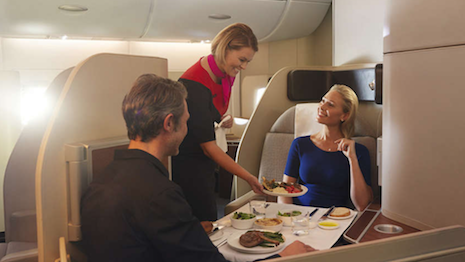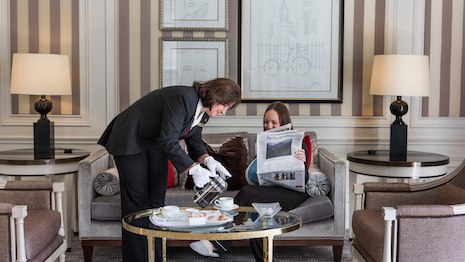A growing number of affluent consumers are looking to get away from typical tourist destinations, according to data from Ipsos.
This trend is especially prevalent among the most frequent and biggest spending travelers, who Ipsos dubs “Jet-setters,” with 65 percent of this group favoring the chance to get away from the norm. As travel continues to replace material goods as a status symbol, choosing uncommon locales can serve as a form of bragging rights.
"Half of affluents agree 'When I go on vacation, I prefer to go to places that are off the beaten track,' an increase from 44 percent in 2016," said Michael Baer, senior vice president of Ipsos Affluent Intelligence. "This can be attributed to a number of factors.
"They are just traveling more, especially internationally," he said. "Forty-eight percent say they plan to take an international trip in the next 12 months, up from 41 percent in 2016.
"They are not visiting the same places, but always exploring. In fact, the vast majority of affluents – 85 percent – say they enjoy going to new travel destinations.
"The growth of the 'Instagram vacation' phenomenon is also a factor – there’s been a rise in the feeling of FOMO and a desire to be first to see new places and have unique and interesting experiences while on vacation more and more, driven especially by millennials. Almost 40 percent of affluents say they want to be the first in their networks to go to a destination or try a new type of vacation or accommodation, while 62 percent of millennials say it."
Travel profiles
Affluent consumers are only about 17 percent of the population, yet they account for 49 percent of total travel spend.
While affluent consumers are a significant force in the travel market, some travelers are more valuable than others.
Jet-setters spend about $24,100 per year on travel between business and leisure trips. This group is highly interested in foreign travel.
With their frequent journeys, 88 percent of this 13.6 million-strong audience is enrolled in a loyalty program.
The second largest spenders are the “Experienced Explorers,” whose annual investment in travel is about $13,200 and who number 14.5 million. Similarly to the Jet-setters, they have a penchant for traveling internationally, with 86 percent journeying abroad to have cultural experiences.
Fifty-six percent of Experienced Explorers say that their airline choices are motivated by rewards programs.
While they may not travel as often as the Jet-setters, the “Taste of First Class” travelers want their trips to be luxurious. This group is smaller, with only 7.3 million individuals, but these consumers spend an average of about $6,200 on their trips per year.

First class dining on the Qantas A380. Image credit: Qantas
For Taste of First Class travelers, quality is more important than quantity, with 80 percent willing to pay more for better service. Fifty-five percent seek out fine wine and food on every vacation.
In contrast to the Jet-setters and the Experienced Explorers, “Domestic Deal Seekers” prefer to stay within the United States. This group is the largest studied, with 20.8 million consumers falling into this behavioral profile.
Even though they stay closer to home, Domestic Deal Seekers still spend about $6,900 per year on travel. Seventy-three percent of them enjoy taking weekend trips.
Two-thirds of this group also favors returning to favorite spots again, contrasting the broader trend of exploring new places.
Also preferring closer trips are “Homebodies,” 55 percent of whom prefer U.S. vacations. This lowest spending group averages $2,600 on annual travel due to their infrequent trips.
Despite not traveling as often, 46 percent of Homebodies are enrolled in a hotel loyalty program.

Almost half of Homebodies are enrolled in loyalty programs for hotels. Image credit: St. Regis New York
When looking at all of these groups, Jet-setters stand out for their affluence and travel spend.
"[Jet-setters] are a very key segment to target for luxury travel brands," Mr. Baer said. "They spend nearly twice as much on travel than the closest travel segment, four times more than A Taste of First Class and Domestic Deal Seekers and 10 times more than Homebodies.
"Their median household income is $17,000 more than total affluents and $27,000 more than A Taste of First Class and Homebodies," he said. "Their median household net worth is over $400,000 more than total affluents and over $600,000 than Homebodies.
"They are more than twice as likely to stay at luxury hotels and fly first class."
Targeted approach
For many of the profiles studied, loyalty programs are a part of the travel experience. But driving loyalty is about more than point-based rewards.
Hotels can earn guests’ return business if they deliver an elevated sleeping experience, but a recent report finds that only 42 percent of luxury hotel guests have had their expectations exceeded.
J.D. Power’s North America Hotel Guest Satisfaction Index Study found that 71 percent of guests who get a better than expected night’s sleep would stay again with the same brand. While luxury hotel brands often emphasize factors such as on-property amenities and service, setting guests up for a restful night can have one of the greatest impacts on their attitudes (see story).
For travels such as Homebodies and Domestic Deal Seekers, some travel companies have launched programs that are catered to those who stay closer to home.
Bespoke travel company Black Tomato is appealing to time-poor luxury travelers with the launch of high-end trips with short plane rides.
The company’s 5 Hours/5 Days itineraries offer jaunts to locations within a five-hour plane ride distance, helping them explore places closer to home. The nearby itineraries aim to provide the same level of exploration as other Black Tomato journeys while enabling consumers to make more out of their travel time (see story).
"First of all, [luxury brands] need to understand their users and their prospects and what they are looking for, what are their needs and expectations for their vacation experience," Mr. Baer said.
"We have identified a number of key travel types – for example Wellness Seekers, Active Challengers, Gourmands, etc. – and identified and profiled their needs and desires while on vacation," he said. "And some of it is surprising. For example, Wellness Seekers aren’t only interested in spas and mindfulness – they want it all, from great food to culture to adventure. And there are no doubt overlaps between travel types – consumers can have different need states for different trip types.
"By understanding their users and prospects better and understanding their needs and expectations, luxury travel brands can provide more relevant offerings, services and messages to them. And they can target the most relevant aspects of their brands to the most appropriate audiences."
{"ct":"H69Z96mdU9GeWJjcqa6Y78F\/uxpnLc8k7ZPtM7Zt5UYU9jEr9iW6kGSZySPSyF8greO6sz\/WPHDfd\/DGvKds2Db1qVOM4J\/r3P4zbbMvf0JYZRJCBBga6Bamaz2vyVhIufZd17pMKL4RakM5F8oT+BK4BBXN7jNLoggqnVJqVUCN9\/QQ7UgFp3W8dHa1P1UDAM4wtC2RRfDe9Ald1tbYNCpBrrCV3QhGUse4TEIWSWN8ThsclxgOH0TBuPaFR8p5919I5Ll8L\/\/waHcodY41axPVDAfwuMtCZbwUypVIIEeCAVXT\/Ne6hHyMkIWU4pGdI6KUcSmuCljmXQ24RZuDLqhAT5IvCP+J1j4qvMwMcI3lThpftAc0s0fj1VCycikVsWaVGCrUORtMcWogJ7YEavK74tlTHbV1zCse9c1u6Z\/KPrgxLPqD5CugDw1XGShlh0sGEPCt4bo2aih6lxWfZxeGZr3UWWvkdXrgsabr\/SNIU84XdVLIRHjCkJY6L3IuRCsNfKoGDG6D5UMBySKclr5NRa3uo7LJK8ZHgqgHI9+Xbfdke8hWFmeXR5VJj0sigXTNrUsZZvRE+qiD+RKTwR48CoLj+lVQjTGiEt1Ge8lqh1HXgX8pYy9ZLAMBdIfXoVQUqwW4CA7nkzuqA+iTAV6gaDRSAkHAP+Ip3AX2635ptH2RGTa9ZqWbYCY1z442axGuxWaE15yexYqbt4q84RkW44HZk4yqN5tAlbnNrGoEZncdcaXP9avhnR+g\/yVL3jd3FjZ2ElakW24uUsQZzR6D6wcdmoX3+479x5Oo3YQxVZCEiYYceyaXAeY8jNzAmEHpRX0iadWILWuMoWgFOg+FXV1feQ\/DX3S2vvly+1CgSxdOnhyI0P4ImMQITQ3qqpyijhxM6MRubypYNrMLHp6PTO4\/rvqqiA2\/aw4y+uy3UVN9OLAnHT3DEgauaCFr6XZ8cTfu1HyYKnH5HD4Dd8LnEHN8T4tFZiRijF8xCTeP1nAjJEFOE51fNZtenNJ+BhuxqoWqZiloMf3ka1k\/RbukndCkEwjCWOxRPMqcDEZY+4bMIu10Xd8Jy8M4HwZ2NsLLBwpAIRjNtWUG5H3thkFpD6qdxYGs7dr\/9JhNPUVe4MlOo8hLHLEjRrdUtfJ8pPIekIo4Zw6ZapqlX3pFHkG8yHqQXuSiqGWebQW6mDX2OB+DqG7ws8Qp\/70pS37bp8TBZtiqyKqCbYKlptU2Y0N\/L6KCfXTh7FrS11Ha5PzGPSfGaVIhXR5VviTeqpvfXeW7Oq3azYf3JY77t5wh2MpEEqxiPzja57LRtf\/cZE+G6PDqq0Tz1CkkOgDzTk3Z2xNGO\/X20aKE8cJhrI4Qej1nA5svfqCRyJxZIegohQlPBc7\/aECktgY7pY7oQvyk\/3k3WQLtyt4dT3TV5L1RaTNrxRl+oShI9b\/nTO\/NPfIfGReTi07L7vezsmF6eq1qEuC4kAoc3pj0klm\/gtscfr24UVM9cyi43gktMJ6MqeFL4RTECD5Y\/W6R+nLxOp8I0P8961e1R7fIs8mG07pgw+WnG0All4T0qGA0ZttVsTrVLKPw6zd64Fh0pIX2N31dJ7myS4KKLz2V\/I+kVTwI32XyLlQbgPJcG\/3kFrJKQ9TmOSBsVuwYA09DtaKfHT8JfIk9\/N1ygXWzzYGFqvLB23NscqszSbRh2jy\/6Ii0QLmyutkVnjq0mf27d4czG9C2EvyGrUZZdYplmzdhN1qpiRmImM29rScEh0k90FEIVf9\/5SbUvw5obov39puXyhHU3+m79uMu6+rgXo+RgkTyalerW4yZ1lI124hjL9x8wnF6pBciym3iMvi4fl0Fo2nGqY9W9hVNdGroNkLF749HXWfYXZA0Kxe+ZjjYRxQejxR6mKb3Hu7zzY3t8hzeLTw\/KFy\/BYrz\/Uyz4i4eYSgst6TayyaZskNKgpQ8Fg5LiAFm5iLXVOznIGAskr1oCgDsU\/exTEket6rPLQ6djQz5dEpRxhiwwg6CstlnGi19N9RYH1Rv+5aJhm+NoFMhhFNwaS\/mWJVb0X5SqlGA8u8uTL0F\/4F8+dFLPwrREvpMF4pnLIvjeW5lO514vU266eDhp38lWWnRXPhbh6\/K1f3VMqdr7hdojEAnlS9CaLi64oh1ZAR3sox7RfvPPAcaiN+YtQOv6roUg9f1cSchwh7TgRv2XYmmRqWPF3b76zDmC7pH0wj4cZ59AN\/THZ5oKusnWGKO54hjthScEfWtBb\/kVWAOloAwmEUgMskJGsSvzW15COK7BgYFaZ74bSrxSe+07KSzu7oYc1qzftbQGcPLUbWItplCDwqb8TwcyUm1mxSPIJtoKM186iSfOUnivDgxTcXe2DLU7G8uN1SiGwha1r9\/xB1\/+iSTICXmegweulhvZ3WYzdHVDAEtd3Jncpxl5Bq8GWkbS2DBuK501Xx6ddIDDRFZmBQrePkc7s4tqFpSI4vraQIu1LRBzeRZ0r046lpHxApXXsF6QOmLBfalMXXZNlsRnaVi\/1H49Cw05pTB9GyoHb88Se+hdV7C9JYjHdWC3jVAtpnmSR03oYXym0W\/jNzx\/y8CQQtiyOfbVlKlSijSw+6ose8rgG4UwakvVUwEx9WchcrENSiKMo+tDkeaEgnDFRjcIPdDFjO8YQvpjLBiSLiqPVDxfBg7VCJKPjnmyWMCUqRbjUoPYeiOyVPHu+D4xSu4n6ck0U6TffusV4+J9kPgM17nBDf1C9Gv0t+kUOLhpR0epWbiKuyUI12rxc8tOjxthyvW9CpLLv66OhVLz2i54PENaWUusRnGD+OVJyGwDZ+2Obz6hsGzr274o5Xp\/BNDnW8VLGBMJ89JoVKVx7GcuJ7JmmOUL1k+v2Kcp9VSitamkxO2VAaaTtbjOe9aLKflHf3lC5WvwfG4638On\/Pu0VfiNt0FwjYUnFWl2d9pEZGTHWMgXoLi1Aa4reK0qg7xv5m1ENIrBAz0YpskMejCBHqZSG\/yu4hDzQvwkNE7KJRM68kSjFE1QJ1LmDI5TZajdzdsiwDb6+2PuES5K48OMCJnYJbhPnble2CAtbKXofsfl\/7NiQ\/6ID0DLRSLX5DDZ7y7VUoseE+anOi+HB8komY+F8zeQKZc0y5Tjq61e\/lgRFHjMls60RTIsHZdYw\/5V+V0gyelJj\/CJR9uRwnUyGQJgsAn7+LQvGXUnQCudPLezuSMzvRyIHc96azdWAlrQbBRHpNToVwd2ufytkCED51t+lGIrAGlOYH\/mg1cq\/OOEJh71mJdLSWOsyuaDcvntNTH2I9hlaxCEFJUqErP5bJ+Rkdc7lrMmUqbFCBY+bSE9rOzZRtjmVMlCUlbmKhQIaw3gsyTKCybvBEUz3lY1yEV74YKqyDvvARXUWURAhxKAgHAl+L9qoLxnpK4h0d7h2RlH299Pdvf7jKVL4Q0GvE0penX\/\/edRXunIDKHcZef+YOngNehyz4mi5cT+EOOW4P9u41sD+7xHC7JsjAHDRJuYBBvmqa2qdX5d5bgLYS2Obg0pxnKTD54LL+GgNf4RN00ziRCDEedx33hUegKMMWGjtUcAJyFTavKl7ibcf6JpfvIUdff2\/XxH0LECwQadwstBw1hlxsXFZzBQruGRAHVKGxAgHPovyv28HvTDPVlzXa6HzR3IOHQ3T2kCBpKR4Y\/dOfpiotV0lI2eW4Nvzz43OXdYa045R+Knuy\/XavaDSjINYR7iG41Dq\/EXGBISXxXYg\/2Hn1vNJwaRIB6+zBfEMzTYy2GG6pnYDr1X9McFS236crwLHa\/grOdt2W4SKclfkYT6Zl0jgeXPAsCKLXKgtHIOSQQoTQdevZwNnXZoo7H4V1BqqPxGAknpbsWFjMbLXfMDkm7gFXGE0ddZ3BkSCVkmlowWsE7iH+A42BqzpNrSznTJ0\/VlMjwwPT0duF7MTrRRLzlMPLWCVNsWI3R8lAGyG\/EXFDVHMfY+RgpvO+9T5nyk8psyBy5kcUbLWOUgSRL5Q0p6yT4vBnxN5Or3jVDRmhn4MYJ+zimUrcOXS9PvDDmij4w1SjUq7gznQT9oeJAqrldXp5Qo9TA9Fw3ovkIYbfIfPj91MVFW+905e08TAprnNs29tRbwVFInzoa4q5KZ4hscT9oLmBOyu+TQPrEaOqVxIdIA0wLJct4iQ8HqRr+0Y0d+G5D7YLO1EsAGOMBOaT5OoMklQ3FZU409JOUXbwy7KzhUafIkiPFA0\/jhskoD473MrZb7lQuoOozj4xvmDXR0nr\/6O19LhHNpE3Bg5yiDm2MPhfr2SBMjBgOfyiNq91yuq7DaUtuG5vyiFNBB66Tdf6tpay0ztDAsPpdNtvc8uAhBRfsJhQ4B4GC0O2pZpS76bu5QwwaCSfdcOdI\/5RDi\/I7WVaF4kmtd4QxzJVhwNZM\/RD5avWQB3U0+OaWAg\/pbdxlLbyfLl4o7pj983QWXi0a1LBRqNQEO45BZGkG+dRzc4xqrjJrk\/WeZBFTgxbfGH3O7T17da7Y0LQKLPizVUD7rLyy0rwa+mlg8MyCDuSV57DsV9Vp7Bk1IL+n9a6yQ9ncR9SazczLX6Om1TnQCnun9EOs4PamRsZKPLsQY7yq9liWWmsGpPbsBDx95JwwKrecRT7RiiqZC0CC\/BWnvMa9EY9FVxnyn5uYEsI7qX28FdDExdmaus18gdoS07w7VNQ+GB8ZryzcSsPe0BNleCWFczZnB0ZQqnUtO5n\/1lPeLp3nHokX4jNyvVkbfxHng+pHthjWSrOZr1OpEGxG3RveicoGfUhANWs3eIVpUQa6\/BMSe61hZ4dsKNmfrLRJarMVqZfrZww5yuL9lG+ShJrBWnmsM1hbYeQY6obXKVe5K7HoE6s0tm4eya9fS2IQV5yIa1q9kG8DiCe0uQOAeS0eOaWoT0eUZ9P8u+1Xu4lAQkhqJnyxrq8OqwndsMjoxGTaLFGIxv2tyY5YQ89fGaN0OKLfuGRmXcuo6mRY8954p1dj49BMByfLJUlD2e+lDbpr+JkbJIokqcpMPJr9wBf7s\/JYfvKid7K4fX\/EwrAHGKk0aSGBXBBbFQAPm8xMoBtuaAtWj\/ufTjkOVqBXLrCNJsA1fv9Ubblquv1pxr7lwmCvReV23QAaUTAmKVmFDKSxDUgr2Tih89xjO67ZH0PATUujxbRr+7wsNPx17G1XDRdYpFhQp+T9g43MrdgbNnTBrwq7bvSvBh5Lkt4kKlRggHC4jzzYu\/z2yZdMXqnGtB0WCTwDT3BZdr9pqj9itx5g2WVn0tiDIw5GZR6iHrzNNygOJau0SxI0SiaqW7bIePgXLFSXxNBVyAph6sChmwBwqaVnvs0Dncg\/LTkLKa8w9A1Z9J4QWVFg\/8ePdjJobJ2N2QdBoWItGKQi+iPBZnkd03MDnYwokMxxa4URhDWdxldz0qYVMlcluhm0HXvAH+TpjcB7xlhAisxqApzRtkpc+\/pDNnfTfWxWthsqD7ydeSnd8TpDEj+DrTF1Ebs5PkNwnCMFpQ\/ihm+86wz647S9HVyTOdsYuI0uHI3MSyChLIQ269ZEuSftDxdoSdZo6l4i6zIo5N\/liQNUWzmU2SF5Z2PF\/MJVVW9+sEirrn5PDnEiVQ31EXjnwaon1eqgZhac6IEhC4pbxSOwK5uYtdlUH8OWyBU3B\/y4XBIUyUxFFcTEd5WsOT2TaY+hZMr6eKNDhu0fKwqw2fnSjggBkXo5EKDFX0Xr5fBlmYup4gkv4l9JN0N6zWnLya6vTrMVpuN8KfJzwbLrs30gXzr0pddXGiPAuvN0BFsEUfUnuUVPgncrRy\/4WyFLLQ8FHxq8xC7fKXEwGmgNTQWPgzqSKts7chYYWe1cgQhylt5e9U9X41I1rcE7TDSMeEWzzvs6vintya38WX5M3l15hQJcUYLxCVFXmjQCFud9IaEvS+005HuVVj5MmSw7oynxF5mLDg1GBx4fvpxR0i1et20fGlllChGTEIwowazdeNPaCN8SKRGcY+\/3DSSNXeM80iBnE7KVG+fH1zFtZI6DeQ2oRf0+Bf3jErGS3TP7Vrgzz3nerS\/MkfPAcmZD3jh8dHpiNspP8xNX2+NZlpzFtvDVpzJhlxIxfxO8xOjoqqDhyQXz6vKshQME9llbEiVP0i+sKHxD+qfLkQeIHwWKKdfQlalRqC5stRjLPrXCu+EsbEZvZQ0DZWfYjU2FTIUm7v8ph3XtYRXv0fg\/l8b60ifYhcAHCT\/sUAKTODAT6MrZ7VGT2TQ\/lc56YFypfrCVnnOP9cEO02CSqv5x1wUeerzq5B2BwlgKJ9JyebU+XTvbBqxv\/+zDRUw2RRpVtOn0Qq8V5d4oUCO9FAITMwYMuxlOTnKRuecmx0P6mASNkLx63XGXW9J8uBElZr8gkfHjghKGGld2+KxQfOVEzkWwvFIVIq1\/\/ihstIX5Ra5bKmJlnBq0Ra\/shI3nbTm3YqoxJQmW4Ike\/ZqhaMdMAy2gW0vnRDOnG7ehe9FaYXTGvP1C\/L853UJxYHcUJHlrMF5fQ6rucwR\/4GsIFq2Q6IAtKlWu16C6w0qxBzpR+aoVk9iHbdcnUq2z7T1zbbsdIhMOtUVxZ3eaxNC1F10TPco2RgSjuhoa5yBmC473iVO2XRt\/yhxVgtvDNDxtVYjlUnwt0hPMMAkeH2Ijb0C5VJjNR03dG5qxn+ViRbNFUDXdy+VeZUZN0zrv5YesM9J0ql7hAk\/R07EYrSPlWrgsioPSNm76zI+NyyzMmlkx\/bH0XIs8AT5zGf7XoUSKHtege1f06YsdChx0w9z+jOkRppaG4d4Qn\/\/9AaL3J1fo+qI+ZOSymwkbi0i7ISA3VPqosRAZbKT2xIessAat85s3M8WXyVLrJyLn2Cer8EjkG2CnDlQ+iBbeNe9ChxC8\/EtF8GSZvJ6p\/FjTY4ReG9GPTEH24i5EhHmZkxSxRs4q0m0iTeFFKHgWzrrZab3MIdUdtjqZRhQswBTMxijwI25ZLjqghXpH18ybBEd2ifWlVTJ9WDzxlPBj+Rr6TlzQ0ILzgnEmEuRriUdGP3diMbo9JinL7gPDv71EHxmWa0ogTzBfBx5yowHQL3agxyk9kTaJh3s+eyLwRR4p4Ots4JTmCr5ZjGQMHtI4FmIoSX+NF9kcMFwbFaLfbwW\/Ur9sSMoRoRkoBhE1DmNB28Y6abNK+EZgqcd9VReHaz3rBqNKF3w08aCDX4TWUJIKPylqWqcB7MNldV0M\/ZCodVlB3ITUD5OGFii3ZFnX1L9VBsdOdNJK6eECf9lHbvNAX7gqk560D\/q923G5TiHvnP73JZbWhF74DUR4Wk0mcJlN\/8QwfuXWHNreTSA+0jxw+J1FOzigjEwnmtgKvROFg3WDrNZX1OtJu2lGEVKk81tDsTnHZtRPI1Y0W4uJpab4AzCzQGvIoKgMMgghf4Nu7xyE+J0MdJ9iS2D0hbLwlKGAYeZA6HWFuTjYZycwoBa0NoDNdpvmHyT1jx7FMok2FdZWnKSzVzeiI\/LJiZEhj0qtk0o\/EqgtgNCP\/Ad4R1xh3NDszdFi5a+B7Si81SdDvEROfwPrDrRgwskIBA\/Ba5kzwzru4YaPhRTltBzZGjug+Fywg1Wv+KnpLr9m2vejUC0bDk1jmCbZ4v8wvsFcrZT3wuLhdKJHLnEVrAN3VE8JIiQ5AoD\/ldLGSISz+eOAnqBba67zgnh7Q4uocZUa\/mO36vs9DLTDYn7uDy7DIPbiHL0KZHMSANwmMNDaaXKtfIBLh\/EuHPIGLMoc2ozfdzV2qbT+J0DBI1M4niMn5v0uZ4n9Oc4x6yO5ZDXL4TyaMDJr6xUGjZ1OJy8l05q9lC98ntDi6Y+4GM1TdiXzPe9ba\/EiJlMAOFShHSPl2NKCDWI6DUG9O84m3i9lIYtSfxAiedPEg2RS6rmG\/q95iK\/mwfQnWvM06y6Hu6gKiSdr7fZIl926pUwiiC0bB5IzKRDDeSxi4v1yqH6T68hGLANoR5y6fv7Rmyw\/lAO0riRqw6D5pDa0+iMZHk2dPLPffgKBb1bYa2RXnkOE9hY4fKthK\/vJT6naL0BGuCxumnFgy2xoL8EqlC6dIjNv1LV5I57RauexFkRT3B457cZ+PKqqUwATFcTqo4tEi3fwUPep3pWqGyi80MviTbTphvEFBAwfYweDbKvO5jAYuwJ5eYvhLbfVvImXzS5Zte9qxg2QpS4ap7imMTQRyrJovu7rrp2Vc\/gFGa3W5ZpDa4WUQOymNPl49XmTTjNRW7fNlDgfhIVYdajmblRjor+Ab34RJJSpEZQ7xqwNO3Ami4JtkORbHuJ+whjHJ\/hz0fYLmGuYEpSlEd6updtX6hxHRZdvW6QOkeqfZWJoX6NoSSSO3tdgBoiqtk8p0NB4s6PbNB1SGDb\/yy00kieXOJuFyeXyfy3uI2pftFHrfrMUPvwGweW8TgILiKq9pQ3ENd29vkyZ9lysY4TQ86R1FNZTTuN7JAoFRlv2wDpKeNXm7IbK5t9YYMaqnV9BI87mOEGZX3a1JzWARFF7RC2F0rUFLN322lIUgwI0FAO1m50aDhd3MYoMuzce5bkEFvCbPZmyRDT6mzDsoriZpGCT3nXXkBoiHpnTGHULrp26tK05ALXcoZHF5l\/nYHxoNjH+02HV\/WUXnP\/NjBhXtHfaf\/c6lkKerAw8HDOQmPTDKX4RXmXBrRYBuy1Xg5JY2TyV3Sn08++HbIFt+TslwGmUVaqf01ISeOyrXRS\/IMcUGjtjCfN7iuUzP20tKIU\/wjJI\/JEt9zOzgRjoPNXmP9caRO8ygRWlDWhbKSd9Mslcxs\/wxqg9b5ttqa230KUW\/IlRJ\/Wf7xG9l3zh+xau0zh6j8s9hWag0dTe+Fi6EHnBlPemlorWI2nY5gLskWt4LcPv01Ld2e9pTvbG8Z95MAI2bCuUE31bkYh1ogi8Fe7H\/UpUtFP8KGAGcefb6N1qB1XleUC9zg0cSlmgm9jAN6ieHY14m0fV7snhkm\/KUoINSNXJmDsulct0vf2Ad20MumGe8PHfjNUTi2drhazcBMj3fNxC1\/b3ggbLOAl\/j6V\/TRl5mJQVkud5RKaGhBbsqXtMTFHWRie8oWkCNtq1tGhKczCoyZohstDpmKynzSortfyPAZA9nAZTZ8BUX2Djxgs0CLp5D6M9VAwuPUX1oCR4BYsMmhdlXs\/u1quUMTduDQYFoAZwhFV\/l4hW\/E5GOh8NGqMc+DqzOygoK3nLQfqTsyE5yYTzsf12kytjW49GxBh0GMLLO+jD2BskB4JzIeysgefONhj1mtmYLHbB9RNCxjGT2NWB9Lnm6DgP4icSQ2fzA8VslBqkFvKuA1TlASsgOSCyPWHHPy7L8nyc8EGlmiVVYUuiTbERRbK8IjxW7d45\/LKHGUuvSo4s1tokxyhdCkm9s2rw\/BJ3uH0ttOFoZ8sCob96hIU2Pjrmm7omP+zAUDw9O3m5bqWPJMDUjZ2aVtM2vTJl7TuFFfeJdlOT5zExCkZrv9mqtBojHK33f5htQRnuWylY7KMIQGRBasRYNKdW87JeYxmTVF2rzHO1iolTVPGj6AOF9gjJw9siTrnCmtmp\/SXdsCyilTAcrGJ9Xif8dJJyniwUme1mOfp\/kwpPW9GA3DwU8aj\/13gdaPiwaWAOgvNuqw\/NXnzX6NO53rXgzxg1TfGWFttSsofJ4MVV9LLuFvJsaGQ9l0LhfaRmQfNxHHzJ5OlohMA4PE+bAKN7ie\/TQUgOC9xGzdSFTepfyRfkGoPHROHV5oi0Spx5EfrEueRi6+dLjpMMqideuoyk4EKH3baD5R1xaT0ilCFgI7U9aznRhliWK1n+OczKN78V\/No+oxBYZXG3v8T0+QKNfVXOpImdHo3Z\/P+GpgHgmLTizugO7kKvDegOVIJiN5bSpwokVL0TDO2vSLsU7WWWf4m5xB9QByO0WcMmLMJbgnM12gmMTUpMyyjLvVgb4HIKkKibCmdGpq+yGp3LmpQugiTFc+WobIBt8c06F\/3HOq\/kTeH8SnWmHHBm\/+OHbf1YoNJQfpXx0TPeUPikQDNZTlFN3rY3UhR9msMAEv8qGPs\/wSnB7IEVjtMI4akdpcra\/dGm1qIAk67TaggyjjIf0+FoQvVQed6oh1i79J87oOiA4WcRpmM60bgDP6lUnQ69ksgfpji9p0GIb1QXZFpquRx1H+PYqZAlf14jnZMXxBLGj+v\/I3yIVXc0+TE+6kvFlZigUCDB29dl9RBpTqXFHwpAKM55vvgUzp4lKlUc8Mr3wfWTXXEN7VF4aY3+oQzln6f30r8mF\/n9zJcnjZ76TWMnTwmeuV4kW7\/9YiheEHZPLD4UQ+WfiZizzqodqGr7e\/ilCioodPHW1ozyXESXVFX\/MfnisGWBJG8hkvvLk02P7i6qBAqdGq1hNVzFrC0RmXYUMz9GonaYG3FcBjgqLTCCeQhDl5j45hNoD54O9YD3SG2d8fqmcCziyRNLvj8h7tRq\/zItWBHMabHF9h+lJiuqx4fymbaLVt6qlXekgiSzqmxiVoTa7U2b+yIyOKDU7t2qVPVA2HCzWnP7e1Mq7U+duJV4bNCVLKpZNs0cx4E\/PAnjMVGoRivx56\/Xt8Qt3hOf6vn1iMrvbzZkAacQgIHDBLsSsIpoDBCe4dbq+wWom3mkaC5JoXxZOcNWk0Hpdp9pJ+qmjC+qX3HkaOuZvyEIyLUb8eaWYXqVTmE35zdGPsRw+RKBrdx9EIr0yRY8XkrsVVX81Ykwx7EZXZ6rSgLaFe1WKZLBGPy761pYtjzmlr1iEUzBPp7Cea79kY0cqtkv6C5GHGb0AEswmpVs9qwhGoAq7p1CjLcNvZpqfAlgJ0EDtRaZsKTTW1QUMYaT0F+Uo2mIWdAjkvJz4LiYMJnZDuV6Gu2PqvR43Me3Lorpfwqdfb8ZxCE9glK2zPlVKz553Klvl8D2tgg8BBl3hWppUB3UWwxx5jSg7w+iNIuVLRs+mQJAqfa9D+OB1whXnC8PRDcme9TUHy0K\/7U5o0lHcxmFOXVhqM\/OH\/U\/Qsus87wdP8NY3sLSXROOUiCRA8M2uj9iSTKjdRkclO2q17Ub2LAYMWZ9OVcztMhpt1cHglvNgkjiy4GITmArl3ayFXhC+FtGn++xOXWXU+UdOsYHhvuHi8\/YbKndOBWXC35wHqmcIQxBDW\/Mf40hR969BchCQHdf4ZpLt9kCbeIS1MKjeN+aDEkv3vXWQaLumLdT7aoNmdl539N6HcMwYXFgFen8xd+sVXmZX29c9FAWVmGlXAQqcSNCi0YIy+SG3tWlHrKaFoTk5vjj5A0\/YX1Qi5Hd6cNAX5F+omOZGRHcduAuWVpbNccitWkqvetsdqZyn6KtG2Hiv33dz0AlEoNaJ4Ytce1w4O8PolfFdGaffIJUXo02AMtPF8XXsXP7Z9A2lbAQRQzm4e4YO8x8pCcozNDCzrAFUFJ4ZauIVAe8yGxAtGQrrt0D2pNmv70JpRJEZrJlH9W7IoczBq+u6cB2affZcTpEXb01KR9\/dDr9CxZvJxm55RLlvCmZoLphb1L10MeHxhlhmIOKClY=","iv":"46f472b704bbfb64b00459f6f6a48507","s":"a531e5c05943a2b9"}

 Affluent travelers are looking to explore new places. Image credit: Rimowa
Affluent travelers are looking to explore new places. Image credit: Rimowa